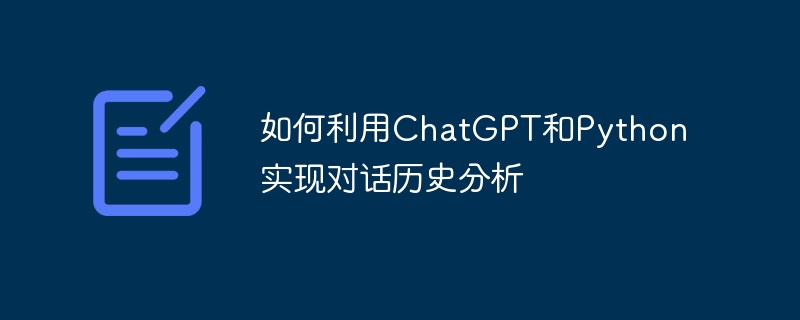Home >Backend Development >Python Tutorial >How to use ChatGPT and Python to implement conversation history analysis
How to use ChatGPT and Python to implement conversation history analysis
- 王林Original
- 2023-10-25 12:36:11838browse

How to use ChatGPT and Python to implement conversation history analysis
Introduction:
The development of artificial intelligence has brought major breakthroughs to natural language processing. OpenAI's ChatGPT model is a powerful language generation model capable of generating coherent and reasonable text responses. This article will introduce how to use ChatGPT and Python to implement conversation history analysis, and provide specific code examples.
- Environment preparation
First, make sure that the Python environment has been installed and the necessary libraries have been installed, including openai, numpy, etc. It can be installed using the pip command. - Get API key
Before using ChatGPT, you need to go to the OpenAI website to apply for an API key. After you obtain the key, keep it in a safe place. - Connect to the API
In the Python code, use theopenai.ChatCompletion.create()method of the OpenAI library to connect to the API. Pass in the key and conversation history as parameters.
import openai
openai.api_key = 'your_api_key'
response = openai.ChatCompletion.create(
model="gpt-3.5-turbo",
messages=[
{"role": "system", "content": "You are a helpful assistant."},
{"role": "user", "content": "Who won the world series in 2020?"},
{"role": "assistant", "content": "The Los Angeles Dodgers won the World Series in 2020."},
{"role": "user", "content": "Where was it played?"}
]
)- Parse reply
API returns a reply object, the reply history of which can be passedresponse['choices'][0]['message']['content ']to obtain.
reply = response['choices'][0]['message']['content'] print(reply)
Through the above code, you can print out the reply generated by ChatGPT.
- Conversation History Analysis
Conversation History Analysis is designed to understand the different characters in a conversation and provide a more comprehensive response based on context. In Python, you can use the following code to achieve this goal:
role = 'assistant' # 需要分析的角色
role_history = [message['content'] for message in history if message['role'] == role]
other_history = [message['content'] for message in history if message['role'] != role]
role_prompt = "
".join(role_history)
other_prompt = "
".join(other_history)
response = openai.ChatCompletion.create(
model="gpt-3.5-turbo",
messages=[
{"role": "system", "content": "You are a helpful assistant."},
{"role": role, "content": role_prompt},
{"role": "user", "content": other_prompt},
{"role": "user", "content": "What is your opinion?"}
]
)In the above code, we use several variables (role, role_history, other_history) Split the conversation history into two parts: the character to be analyzed and the other characters. Pass the two parts into the API as trigger statements respectively, and you will get a more comprehensive reply.
Conclusion:
Using ChatGPT and Python, we can easily implement the function of conversation history analysis. By appropriately adjusting the content and roles of conversation history, we can obtain more accurate and targeted responses. This technology can play an important role in scenarios such as intelligent customer service and virtual assistants.
It should be noted that as a language generation model, ChatGPT still has some potential problems, including that the generated content may be inaccurate and biased. In practical applications, corresponding tuning and filtering are required to ensure that the generated responses meet expectations and ethical guidelines.
The above is the detailed content of How to use ChatGPT and Python to implement conversation history analysis. For more information, please follow other related articles on the PHP Chinese website!
Related articles
See more- How to merge two lists in Python
- I asked ChatGPT a few PHP questions and let's see what this guy answered.
- 3-minute quick tutorial on how to use ChatGPT. Use it to help me write my resume. It's awesome.
- AI Encyclopedia: How ChatGPT works
- An in-depth comparison of two popular AI language models, ChatGPT and GPT3

